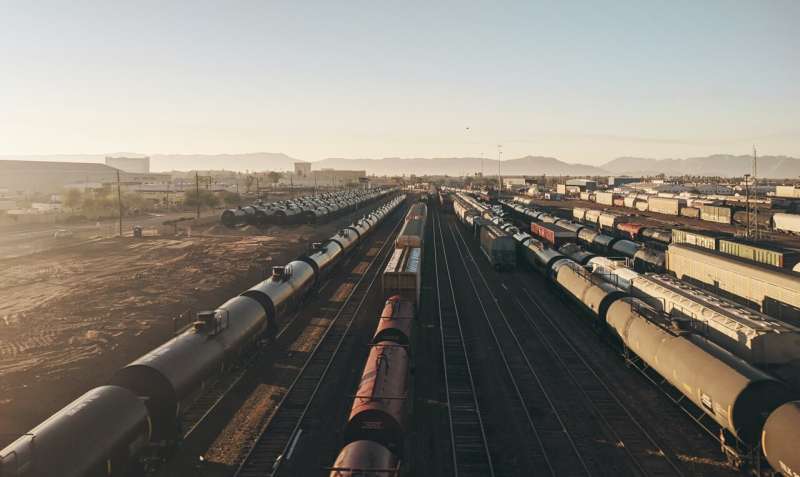This article has been reviewed according to Science X's editorial process and policies. Editors have highlighted the following attributes while ensuring the content's credibility:
fact-checked
trusted source
proofread
Expand railways in poorer countries to achieve climate goals, new research says

A new study has made a compelling case for significantly expanding rail infrastructure in low- and lower-middle-income countries (LICs and LMICs), in order to reach climate goals and provide economic benefits.
The white paper, titled "Bridging the Rail Finance Gap: Challenges and Opportunities for Low- and Lower-Middle-Income Countries," is jointly authored by the International Union of Railways (UIC), ALSTOM, University of Birmingham, and Roland Berger. It has been launched in celebration of the first UN World Sustainable Transport Day.
LICs and LMICs currently have substantially less rail infrastructure than High-Income Countries (HICs), with an average network density of 4.95 km per 1,000 km of surface area compared to HICs' average of 50 km. The research emphasizes the coordinated efforts needed by International Finance Institutions (IFIs), governments, the rail industry, and the international community to unlock the potential that railways can play in achieving climate goals while providing substantial economic benefits in LICs and LMICs.
The white paper outlines that if transport emissions in LICs and LMICs grow at the same rate as high-income countries, global emissions could increase by 16%, which is an additional 8.5 billion tons of CO2 being emitted annually. Urgent action needs to be taken to expand and improve railways and rail infrastructure in these countries so that it can be part of the solution to this problem.
Despite being home to over half of the world's population, these countries only account for 17% of transport-related emissions. While being the lowest contributors to emissions, these countries are the ones that first and more intensely see the impacts of climate change.
The research says that investing in rail for LICs and LMICs could help these countries achieve climate goals by quadrupling rail modal share to 8%, avoiding a total of 1.8 Gt of carbon emissions by 2050, while offering additional economic advantages such as trade growth, job creation, increased accessibility, and connectivity, contributing to sustainable development goals.
One of the main challenges to achieving this is securing adequate financing in these countries. The research identifies seven recommendations for increasing financing flow into rail projects in LICs and LMICs.
The recommendations are:
- High-Income Countries Grant Funding: Acknowledge the importance of decoupling transport emissions growth, providing substantial funding for rail projects through grants as part of the annual $100 billion climate finance commitment.
- Paris Agreement Support: Governments must encourage rail projects to be funded under Article 6 of the Paris Agreement, generating carbon credits for emission reductions.
- IFI-led transformation: International Financial Institutions should update cost-benefit analysis methods for rail projects, prioritize low-carbon modes, and increase funding allocated to rail.
- Government Policies: LICs and LMICs should lead the implementation of policies to spur private investment in rail, align to standardized technical standards, and incentivize modal shift.
- International Finance Sector Support: The sector should work to make financing rail projects more attractive to the private sector and assist LICs and LMICs in building institutional and technical capacity.
- Collaboration with Rail Industry: Policymakers in LICs and LMICs collaborate with the rail industry to structure projects, leveraging private sector expertise, and maximizing broader economic benefits.
- Technological Advancements: The rail industry should continue leveraging digitalization and advances in rail technologies to improve project attractiveness and reduce costs.
Francois Davenne, UIC director general, commented, "This white paper shows that economic benefits of railways are not adequately captured in financial models—it is time to level up finance and grant LICs and LMICs with the tools to advance sustainable development, without further comprising the financial health of their economies."
Cécile Texier, vice president of CSR and sustainability, Alstom Group added, "This study lays out a concrete roadmap for transforming transportation through sustainable rail infrastructure. It clearly demonstrates how targeted investments and strategic planning in rail systems in low-income and lower-middle-income countries can lead to substantial CO2 reductions and support sustainable development. This is about making tangible progress in our global environmental goals while shaping the future of mobility."
Paul Plummer, professor in rail strategy at the University of Birmingham's Center for Railway Research and Education, concluded, "We are delighted to have coordinated this work and grateful for the contributions from experts from across the world in this important white paper. This study will be featured in a program of events highlighting research to help tackle the climate crisis in our campuses in Dubai and Birmingham, during COP28. We hope that this research will global community to action, in order to create an economic and environmentally fairer future for us all."
More information: Paper: Bridging the rail finance gap—challenges and opportunities for low- and lower middle-income countries
Provided by University of Birmingham




















